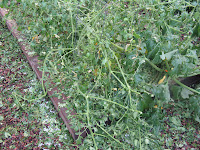 Now is the time to finish seeding or transplanting 50 to 60 day crops to mature in Fall. We just finished installing kale, red and golden beet transplants (photos). Even though it's hot now, these crops and others including lettuce will grow and be of good quality as they mature in cooler fall temperatures.
Now is the time to finish seeding or transplanting 50 to 60 day crops to mature in Fall. We just finished installing kale, red and golden beet transplants (photos). Even though it's hot now, these crops and others including lettuce will grow and be of good quality as they mature in cooler fall temperatures. Planting a second crop where spring crops leave "vacancies" increase yields from a given square footage of soil during a growing season. Rotate crops and don't plant same family plants such as kale following cabbage. We planted beets following lettuce and cabbage, and kale following beets.
Planting a second crop where spring crops leave "vacancies" increase yields from a given square footage of soil during a growing season. Rotate crops and don't plant same family plants such as kale following cabbage. We planted beets following lettuce and cabbage, and kale following beets. This higher demand on garden soil is equivalent of a full season crop such as tomato or potato. It requires adequate organic matter and fertility to meet the needs of the second crop so do be sure your soil is prepared to handle succession planting.
This higher demand on garden soil is equivalent of a full season crop such as tomato or potato. It requires adequate organic matter and fertility to meet the needs of the second crop so do be sure your soil is prepared to handle succession planting. Photo credit: Transplanted kale, red beet, golden beet - all Carl Wilson











